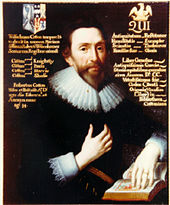Robert Bruce Cotton
Sir Robert Bruce Cotton, 1. Baronet (* 22. Januar 1571 in Denton, Huntingdonshire; † 6. Mai 1631 in Westminster, London) war ein englischer Politiker und Gründer der Cotton Library.
Leben
Cotton stammte aus der englischen Grafschaft Huntingdonshire. Er besuchte die Westminster School und das Jesus College in Cambridge. William Camden weckte in Cotton das Interesse für antiquarische Studien, sodass dieser begann, eine Bibliothek aufzubauen. Er war mehrmals Mitglied des englischen Parlaments, 1601 für Newtown, 1604 bis 1611 für Huntingdonshire, 1624 bis 1625 für Old Sarum, 1625 bis Thetford und 1628 bis 1629 für Castle Rising. Er half dabei, die Einführung des Titels Baronet als Geldquelle für König Jakob I. zu entwerfen. Trotz einer frühen Phase, in der Cotton das Wohlwollen Jakobs I. genoss und in der er am 29. Juni 1611 zum Baronet, of Connington in the County of Southampton, erhoben wurde,[1] entwickelte Cotton antiroyalistische Ansichten und die Behörden fürchteten den Nutzen seiner Bibliothek, die deshalb 1630 beschlagnahmt wurde. Seine Erben bekamen nach Cottons Tod die Büchersammlung zurück. Seinen Adelstitel erbte bei seinem Tod 1631 sein Sohn, der Parlamentsabgeordnete Thomas Cotton (1594–1662).
Die Cotton Library, die größte Privatsammlung von Manuskripten, wurde schließlich von Cottons Enkel der Nation gespendet und befindet sich jetzt in der British Library.
Cottons Bibliothek war in einem 8 × 2 Meter großen Raum mit Bücherregalen. An jedem Regal war die Büste einer antiken Person befestigt. Sie werden, gegen den Uhrzeigersinn, folgendermaßen katalogisiert: Julius Caesar, Augustus, Kleopatra VII., Faustina, Tiberius, Caligula, Claudius, Nero, Galba, Otho, Vitellius, Vespasian, Titus und Domitian (Domitian hatte nur ein Regal, möglicherweise, weil es über der Tür war). Die Manuskripte werden nach den Kriterien Bibliothek, Regal und Nummer bestimmt. Das Manuskript von Beowulf beispielsweise wird durch die Angabe Cotton Vitellius A.xv bezeichnet, das Manuskript von Pearl ist durch Cotton Nero A.x bestimmt.
Einige ausgewählte Manuskripte
- Codex Cottonianus
- Cotton Julius A.x Old English Martyrology
- Cotton Augustus II.106 Magna Carta: Exemplification of 1215
- Cotton Cleopatra A.ii Life of St Modwenna
- Cotton Faustina A.x Additional Glosses to the Glossary in Ælfric’s Grammar
- Cotton Tiberius B.v Labour of the Months
- Cotton Caligula A.ii A Pistil of Susan
- Cotton Claudius B.iv Genesis
- Cotton Nero A.x. Pearl
- Cotton Nero D.iv Lindisfarne Gospels
- Cotton Galba A.xviii Athelstan Psalter
- Cotton Otho C.i Ælfric’s De creatore et creatura
- Cotton Vitellius A.xv Beowulf, Judith
- Cotton Vespasian D.xiv Ælfric’s De duodecim abusivis
- Cotton Titus D.xxvi Ælfwine’s Prayerbook
- Cotton Domitian A.viii Anglo-Saxon Chronicle (Version E)
Literatur
- Cotton, Sir Robert Bruce. In: Encyclopædia Britannica. 11. Auflage. Band 7: Constantine Pavlovich – Demidov. London 1910, S. 256 (englisch, Volltext [Wikisource]).
Weblinks
- Sir Robert Bruce Cotton 1. Baronet in Britannica online
Einzelnachweise
- ↑ Baronetage: COTTON of Connington, Hants bei Leigh Rayment’s Peerage
| Vorgänger | Amt | Nachfolger |
|---|---|---|
| Titel neu geschaffen | Baronet (of Connington) 1611–1631 | Thomas Cotton |
| Personendaten | |
|---|---|
| NAME | Cotton, Robert Bruce |
| ALTERNATIVNAMEN | Cotton, Sir Robert, 1. Baronet |
| KURZBESCHREIBUNG | englischer Politiker und Gründer der Cotton library |
| GEBURTSDATUM | 22. Januar 1571 |
| GEBURTSORT | Denton, Huntingdonshire |
| STERBEDATUM | 6. Mai 1631 |
| STERBEORT | Westminster, London |
Auf dieser Seite verwendete Medien
Portrait of Sir Robert Cotton, 1st Baronet (d.1631) of Connington. Collection of Society of Antiquaries, London. Arms of Cotton (Ancient): Argent, a bend sable between three pellets. The arrangement as seen on monuments in Exeter Cathedral to Bishop William Cotton (d.1621), Bishop of Exeter and on monument to his grandson Edward Cotton (d.1675), Treasurer of Exeter Cathedral, may be th result of 20th c. restoration.(See images[1]). William Cotton (fl.1378,1400) lord of the manor of Cotton in Cheshire, married Agnes de Ridware, daughter and heiress of Walter de Ridware, lord of the manor of Hamstall Ridware in Staffordshire.(Vivian, Lt.Col. J.L., (Ed.) The Visitations of the County of Devon: Comprising the Heralds' Visitations of 1531, 1564 & 1620, Exeter, 1895, pp.240-1) The junior branch of the Cotton family descended from Agnes de Ridware adopted the armorials of Ridware (Azure, an eagle displayed argent) [1] in lieu of their paternal arms of Cotton, which junior branch included Sir Robert Cotton, 1st Baronet, of Connington (1570-1631), founder of the Cottonian Library. The senior branch, of which Bishop Cotton was a member, retained the ancient arms of Cotton (Argent, a bend sable between three pellets). Arms: Cotton impaling Wessenham/Weasenham (of Norfolk?) (Sable, a fess dancette between three mullets pierced argent) of 4 quarters. Arms of Weasenham recorded by Weever in East Winch Church, Norfolk (The antiquities of King's Lynn By William Taylor (antiquary.), p.43[2]).



